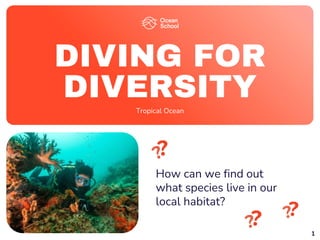
BiodiversitysurveyactivityFreeDistancelearning-1.pptx
- 1. DIVING FOR DIVERSITY Tropical Ocean How can we find out what species live in our local habitat? 1
- 2. Here’s your challenge: Perform a biodiversity survey! Here’s your to-do list: Step 1 Learn what a biodiversity survey is and why people use them. Prepare to perform your own biodiversity survey. Step 3 Go out in the field and record your findings during a biodiversity survey. Share your results with others! 2
- 3. Biodiversity survey What is a biodiversity survey? A biodiversity survey is observing and recording EVERYTHING that you see in one location (like a beach or a field) over time. The goal is to describe all of the living things and their habitats so we can monitor (keep track of) what happens to them. This information is used as a starting point for further scientific or conservation work. Biodiversity surveys are usually performed by a team of experts recording as much as possible: plants, soil, birds, reptiles, amphibians, bats, fish, coral, algae, geology, invertebrates, you name it! Why are biodiversity surveys important? 1 Helps identify species at risk of extinction. 2 Identifies important habitats to protect for these species. 3 Finds special habitats or areas especially high in biodiversity. 4 Helps to set a baseline to monitor changes. 5 Identifies threats to species Did you know? Often, new species are discovered during biodiversity surveys! 3
- 4. Biodiversity survey What information is collected during a biodiversity survey? Have a look at this example data collection sheet to see what kind of information that scientists collect. 4
- 5. Plan Step 1: Prepare to perform your own biodiversity survey. Think about the following: ● TIME: You may see different species at different times of day. ● TYPE: Is there a type of species that you would like to survey? Some options are given, or choose your own. ● LOCATION: How big is your area? Do you expect to find many or few species in your location? Why? ● RECORDING information: How will you record your observations? You can use the templates on slide 7 and slide 8 or use your own system. ● MATERIALS: What will you need to perform the biodiversity survey? Remember to capture what the species looks like, with drawing tools or a camera, for example. 5
- 6. Plan Step 2: Write your plan here. What type of animal or plant will you survey? What time(s) will you go? Where are you going to survey? How will you record your observations? What materials will you need? Are you working in a team? Assign roles! Make sure everyone knows what information they are collecting. 6
- 7. Biodiversity Survey Date: Name: Start time: End time: I am surveying: CHOOSE ONE from this list: Plants, Fish, Marine mammals, Bats, Reptiles, Birds, Rodents, Invertebrates, Domestic animals (pets) Sketch or paste a screenshot of the species Species Name Quantity Seen Brief Description Image recorded 💡 Tip: Need more space to write? You can use the next slide 7
- 8. Biodiversity Survey Species Name Quantity Seen Brief Description Image recorded 💡 Tip: Need more space to write? You can make a copy of this slide for more space. 8
- 9. ? Share your findings Work with your teacher and your classmates to create a shared database of all of your classmates’ biodiversity survey results! Create a shared Google Slides document and add each of your biodiversity surveys to it or Print out each of your biodiversity surveys and post them on a bulletin board in your classroom! or Think of another idea with your classmates and make it happen! 9
- 10. Reflect What did you learn while performing your biodiversity survey? What things might have limited the biodiversity in this area? What could help increase biodiversity in the area? 10
- 11. Reflect Is biodiversity important to you? Why? Write about 3 things you learned while reading your classmates’ biodiversity surveys. 11
- 12. Go the extra nautical mile! You are a scientist! Jump into one of these projects below to contribute your knowledge to the greater science community. Try iNaturalist’s Seek App Take part in a Bioblitz! Join the yearly City Nature Challenge 12
Editor's Notes
- Biodiversity survey information adapted from: https://www.conservation.org/docs/default-source/publication-pdfs/ci_rap_rapid-assessment-program_discovering-and-describing-nature_factsheet_2012.pdf?Status=Master&sfvrsn=543916e1_3